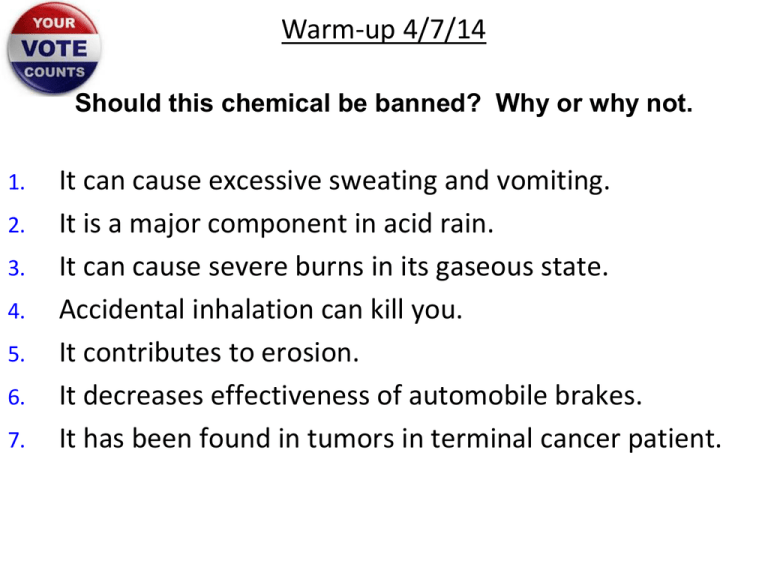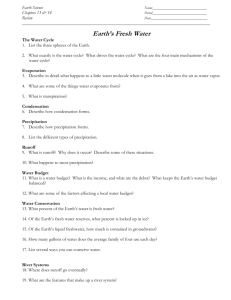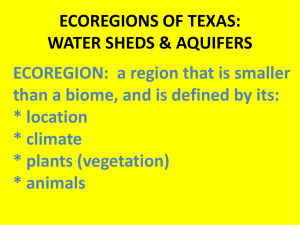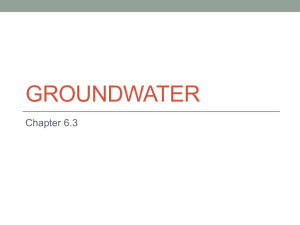Water Resources
advertisement

Warm-up 4/7/14 Should this chemical be banned? Why or why not. 1. 2. 3. 4. 5. 6. 7. It can cause excessive sweating and vomiting. It is a major component in acid rain. It can cause severe burns in its gaseous state. Accidental inhalation can kill you. It contributes to erosion. It decreases effectiveness of automobile brakes. It has been found in tumors in terminal cancer patient. Water Resources Where does your drinking water come from? I. Earth’s Water Supply A. Where is Earth’s water? 1. 97.2% - oceans 2. 2.2% - icecaps and glaciers 3. 0.6% - surface or groundwater B. Earth’s supply of fresh water is continuously being renewed through the water cycle 1. Definition – the movement of water from the oceans and freshwater sources to the air and land and finally back to the oceans 2. Processes: a. evaporation – from surface water, soil and organisms b. condensation – air containing water vapor cools and forms clouds c. precipitation – rain, sleet, snow, or hail i. may run-off into surface water ii. may infiltrate into groundwater d. transpiration Review Questions 1. What percentage of Earth’s water is available to us as fresh water? .6% Now do the Water Cycle Worksheet. II. Surface Water A. Running Water 1. Includes rivers and streams 2. May enter through surface run-off from the surrounding watershed (the land area from which surface run-off drains into a system of rivers and streams) NC River Basins Journey of a River B. Standing Water 1. Includes lakes, ponds, wetlands (ie. swamps and marshes), and reservoirs 2. Form when run-off gets caught in low places, or by artificial means Do Now 1. What percent of freshwater is there in the world? 2. What percent of freshwater is frozen in glaciers? 3. What is a watershed? III. Groundwater A. Water continues to move downward after it hits the ground, through permeable layers of soil and rock, then stops moving when it reaches an impermeable layer of rock B. Water table – the level below which the ground is saturated with water 1. May be high in some areas (ie. near the sea, or in low-lying forests), and deep in others (ie. deserts) 2. Depth may change with precipitation, drought, or overuse of wells C. Aquifers – layers of rock or sediment that allow groundwater to pass freely; sources of groundwater 1. Rate of movement varies with amount of precipitation, porosity of the rock, and slope of the aquifer 2. Groundwater may leave the aquifer and become surface water at the “zone of discharge”, may pump out on its own (when under pressure) through an “artesian well”, or may be accessed by drilling wells Saturated zone: pore spaces are completely filled with water. #5.3 Aim: What is groundwater? Agenda QOD (10) Lesson: groundwater (15) Now write the definitions on the back of your picture. Aquifer: an underground layer of permeable rock or sediment that contains water. Water table: The top of the region that is saturated, or completely filled with water Impermeable: substance that liquids cannot flow through Permeable: substance that liquids can flow through Artesian well: a well in which water flows to the surface naturally because it is under pressure Well: a hole in the ground that reaches down to the saturation zone Zone of Aeration: A region below the Earth's surface that is marked by the presence of both water and air in the pores of rocks and soil. Cone of Depression: The region shaped like an inverted cone, in which the water-table is drawn down or depressed in the vicinity of a borehole from which groundwater is being abstracted by pumping. Artesian Well Review Questions 1. What is a watershed? How does water get from a watershed to a river? The land area from which water drains into rivers and streams. 2. Describe how groundwater forms. Water moves down through the ground through permeable layers of rock until it hits an impermeable layer. 3. What causes the differences in the depth of the water table? Precipitation Drought Overuse 4. Name 2 ways that we may obtain water from an aquifer. Drilling wells or artesian wells. IV. Uses of Water A. Residential use 1. The average person in the U.S. uses about 300 L of water each day 2. Uses include personal hygiene, cleaning, flushing toilets, gardening/landscaping, car washing, and recreational activities How long can we keep this up? B. Industrial use 1. About 44% of all fresh water is used by industry 2. Uses include transporting goods, disposal of waste, generating power, cooling machinery, mining and refining natural resources, manufacturing raw materials, and producing synthetic materials C. Agricultural use 1. The single largest user of water in the U.S. (almost ½ of all freshwater use) 2. Irrigation – the process of bringing water to an area for use in growing crops Review Questions 1. Compare your daily residential use of water to that of a person in a developing country (like Kenya). What ways do you use water that they probably do not? -daily shower -wash cars Exit Ticket 1. Make a list of all of the ways that you have used water yesterday. Don’t forget to include industrial and agricultural uses! Do Now 3-28-13 1. What is the difference between a drill well, and an artesian well? 2. What percentage of Earth’s water is available to us as fresh water? 3. Describe how groundwater forms. V. Water Resource Problems A. Overdraft 1. Occurs when a body of water is drained faster than it is filled; may occur in surface water or groundwater Ex. The Ogallala aquifer is the largest aquifer in the world and supplies water to 8 midwestern states; the water in this aquifer is expected to last only 40 more years Ogallalla Aquifer 2. Other problems with overdraft– a. intrusion of salt water into freshwater aquifers (coastal aquifers) b. subsidence, or sinking, of bedrock B. Habitat degradation or destruction 1.Includes water diversion (changing stream courses), building dams and reservoirs, and draining wetlands 2. Damages or destroys habitat of aquatic organisms such as fish, amphibians, and invertebrates, as well as migratory birds Extinct woodpecker because of habitat loss Review Questions 1. What is overdraft? What causes overdraft? Overdraft occurs when a body of water is drained faster than it is replenished. 2. Why do humans change stream courses, build dams and reservoirs, and drain wetlands? The main reason is to develop the land. 3. What do humans need to do in order to solve some of our water resource problems? Make water conservation a priority. VI. Water Treatment A. Removing Salts 1. The process by which salts are removed from the water is called desalination In 2002 there were about 12,500 desalination plants around the world in 120 countries. They produce some 14 million m3/day of freshwater, which is less than 1% of total world consumption. 2. Methods: a. Distillation – water is heated to boiling so water evaporated but salt remains; water vapor is cooled and fresh water collected b. Reverse Osmosis- salt water is forced through a strainer that traps the salt and lets the fresh water pass Distillation c. Freezing – salt water is frozen and separates, forming an ice and brine slush; ice can be melted to obtain fresh water B. Water Purification Water Purification 1. This process removes harmful chemicals and microorganisms that make the water unpotable, or unfit to drink 2. Process: a. Screening – traps and removes large debris from water b. Sedimentation – i. water passes to large settling tanks where particles suspended in the water settle to the bottom as sediment ii. chemicals called coagulants may be added to cause the particles to clump together and aid in settling c. Filtration – water is passed through a filtering material such as fine sand to remove smaller particles d. Aeration – •water is exposed to air and sunlight by allowing it to spray into the air or flow as a waterfall •bacteria enter the water and break down organic matter and oxygen is mixed in; this process improves the smell and taste of the water e. Sterilization – water is exposed to extreme heat or chemicals such as chlorine in order to remove harmful bacteria and microorganisms B. Water Purification Review Questions 1. If the ocean was your only source of water, what process could remove the salt so it would be drinkable? Describe how this might be done. Distillation or reverse osmosis 2. What does “unpotable” mean? It means that it is unsafe to drink. 3. Name the 5 steps of the water treatment process. 1.Screening 2.Sedimentation 3.Filtration 4.Aeration 5.Sterilization









